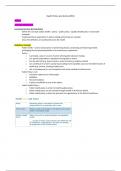Health Policy and Action (HPA)
WEEK 1
Lecture 1 Introduction
Learning outcomes (introduction)
- Define the concepts ‘public health’, ‘policy’, ‘public policy’, ‘(public) health policy’ and provide
examples
- Understand basic approaches in policy-making and provide an example
- Know the definition of coordinated action for health
Definition concepts
- Public health = science and practice of preventing disease, protecting and improving health,
prolonging life and promoting health of a community or population
- Policy =
o Is principle, value or course of action which guides decision-making
o Can specify expectations, regulations and guides to action
o Can be informal (e.g. house rules) or more formal (e.g. healthy schools)
o Can contribute to a fairer society by providing more equitable access to the determinants of
health (e.g. income, housing, health care)
o Has a consequence for non-compliance and some method of enforcement
- Public Policy is not:
o A position statement or white paper
o Guideline
o Recommendation
o A policy may BEGIN as one of the above
- Public Health Policy =
o Public health policy is similar to healthy public policy
o Public health policy can be realised through Health in All Policies (HiAP)
o Public health policy is about the provision of organisations in the field of healthcare
, - Example rationaal appraoch: ontwikkeling en implementatie van verkeersveligheidsbeleid
- Example interactief approach: te vinden in stedelijke ruimetelijke planning
Policy and politics
- Politics is any pattern of influence (control, power, authority) that involves persistent human relations
- Political strategies aim to change
• power of supporters and opponents
• position of supporters and opponents
• players who are mobilised
• perceptions of the problem and policy
- Invloeden vanuit cultuur (normen en waarden), geschiedenis, sociale media etc.
Health Policy and Action
- Action to be undertaken for better health
- Coordinated Action for health
o = action in which organizations and clients in one or more sectors work together to jointly
achieve a health outcome in a way which if more efficient than might be achieved by the
health sector working alone
Health actions: Ottowa Charter of Health Promotion
, -> dit vak linker kolom
(socioeconomic and political context)
Learning outcomes (WHO)
- Know the organisations: WHO, Health Assembly, Commission on Social Determinants of Health, WHO
Regions
- Understand the roles of the WHO in public health (policy)
- Welfare state regimes
o Know the characteristics of different types of welfare state regimes
o Explain how the welfare state regime impacts (inequity in) health and well-being
Global Health Policy
Who?
- World Health Organisation: Specialised agency of the United Nations
, - WHO regions:
WHO
- Mission in 1948: the attainment by all people of the highest possible level of health
- Mission today: to achieve full health potential for all
- Basic values of WHO:
● Health is a human right
● Equity for all (solidarity)
● Shared responsibility
WHO view on health
- Health For All: a WHO programming goal which envisions securing the health and well being of people
around the world.
- Health should be regarded as an objective of economic development.
- Literacy for all.
- The health services must be accessible to all. Immunization must achieve universal coverage.
- A holistic concept calling for efforts in agriculture, industry, education, housing, and communications,
just as much as in medicine and public health.
Major tasks WHO
- 1948: combat disease, especially infectious disease, and to promote the general health of the people
in the world.
- Today also:
● combat HIV/AIDS, tuberculosis and non-communicable diseases
● Mental disorders, violence and injuries, road safety, physical activity
● Global initiatives, e.g. surgery, trauma care
- And again: emerging infectious diseases (leiderschap in geval van crisis)
WHO response to outbreaks
- WHO supports countries to control outbreaks
▪ Define and prioritize research
▪ Enhance surveillance of virus
▪ Strengthen capacity in risk communication




